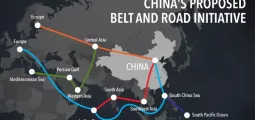Solar Power in Brazil: Waking Up to the Power of the Sun
 Boosting Brazil’s deficient energy production with large-scale solar power would seem a no-brainer: Both the required vast tracts of land and ample sunshine are available for the taking. Still, with an installed generating capacity of an estimated 17MW, solar power barely satisfies 0.01% of the country’s energy consumption.
Boosting Brazil’s deficient energy production with large-scale solar power would seem a no-brainer: Both the required vast tracts of land and ample sunshine are available for the taking. Still, with an installed generating capacity of an estimated 17MW, solar power barely satisfies 0.01% of the country’s energy consumption.
However infinitesimal at the moment, solar power is definitely on the rise and leading Chinese photovoltaic module maker Yingli Green has taken note. The company already ships some 30% of all solar panels used in Brazil and now aims to become a household name in that country by co-sponsoring the 2014 World Cup.
Yingling Green is also supplying the 3,650 mono-crystalline silicon panels used in the construction of Brazil’s largest photovoltaic plant to date: The net-metered 1.5MW solar power facility of Neoenergia in the north-eastern state of Pernambuco – one of the few places in Brazil where local authorities actively support alternative energy projects with fiscal incentives.
Brazil has a lot going for it as a host to solar power initiatives. Boasting a well-developed power grid that is easily plugged into, the country also basks in sunshine. Fully half of the Brazil’s 8.5 million square kilometres landmass enjoys a notably high solar incidence (the optimum angle at which the sun’s rays hit photovoltaic panels) during four to six hours a day. This dry fact translates into a most enticing daily electricity generating potential of up to 6kWh / m2.
“Brazil has a lot going for it as a host to solar power initiatives. Boasting a well-developed power grid that is easily plugged into, the country also basks in sunshine.”
At last year’s energy supply contract auction of the federal government, solar power was but a footnote. However, utility-scale projects were still awarded some 122MW in long-term energy purchase agreements, signalling the willingness of the energy regulator to give solar power a chance to prove itself in a country awash in hydroelectric energy potential.
Potential is the key word here. Brazil has plenty of it, but has also lagged behind in the harnessing of its hydropower. The completion, in 1984, of the Itaipu Dam – spanning the Paraná River on the border with Paraguay and still the largest of its kind in the world – was followed by almost two decades of lacklustre, small-scale dam building.
Only recently construction fever has returned with 25GW worth of hydropower projects in either the construction or planning phase. The 11.2GW Belo Monte Dam taming the mighty Xingu River in Pará is scheduled for completion later this year. Still, the Belo Monte Dam stands as a testament to the painfully slow pace at which Brazil edges forward with its electricity-generating plans: The dam has been on the drawing board since as far back as 1975 and was delayed time and again by allegations of corruption and concerns for the environment that resulted in lengthy court battles.
It is precisely because of this molasses-like pace of progress, that solar power may have a fighting chance in Brazil as a quick fix in places that need a dependable supply of relatively cheap energy even as the economy as a whole is suffering from acute power shortages. Just as it happened thirteen years ago, prolonged drought conditions have now again seen the reservoirs of large hydropower plants drop to critically low levels. The country’s national grid operator ONS (Operador Nacional do Sistema Elétrico) recently sounded the alarm as water levels of the main dams supplying Brazil’s industrial heartland in the south-east shrank to below 30% of capacity.
The energy crisis of 2001, still fresh in most people’s memory, saw the introduction of a “volunteer” rationing scheme that recommended users to cut power consumption by at least 20%. People even stopped watching their beloved telenovelas. Those who did not manage to cut power usage by the required amount had their electricity cut off. The crisis eventually abated when the rains returned but not after causing an estimated $26bn of economic damages and impacting GDP growth.
The current energy shortfall is being tackled by importing increasing volumes of liquefied natural gas (LNG) at a premium price. This already derailed President Dilma Rousseff’s plans to cut energy prices by 20% this year in a bid to help ease the burden on poorer Brazilians. In fact, the government now mulls energy price hikes instead.
Solar power generators are also being helped by a new federal law that streamlines the previously cumbersome process by which smaller-scale energy suppliers can plug into the national grid. This law now enables energy suppliers with less than 1MW of installed capacity to transport and sell their power more easily to the end consumer. Moreover, further legislative improvements are in the offing with a proposed fast-track approval process for solar power generators and a revised fiscal regime for alternative energy producers.
Photovoltaic energy is increasingly seen as a valid alternative to the subsidy-slurping thermal energy patches now being applied to stave off power shortages. It offers an exceptional value proposition insofar that solar power projects in Brazil can be quite competitive on the electricity spot market and photovoltaic plants can be erected in a fraction of the time it takes to obtain regulatory approval for more conventional modes of power generation.
You may have an interest in also reading…
Exclusive Interview with IBM: Leading in a Hybrid World
How do you define a hybrid cloud platform and how is it driving client’s digital transformation? Hybrid cloud is IT
World Bank Group: Financial Inclusion – Banking on Low-Income Households
Financial exclusion restricts economic opportunity and constrains poverty reduction. Yet today there are an estimated 2.5 billion adult people worldwide
Norwegian-African Business Association (NABA): Private Business as Educator – Bridging Africa’s Job-Skills Gap
In the wake of the global financial crisis, Africa’s sustained economic growth over the last decade has compelled the global



























































































